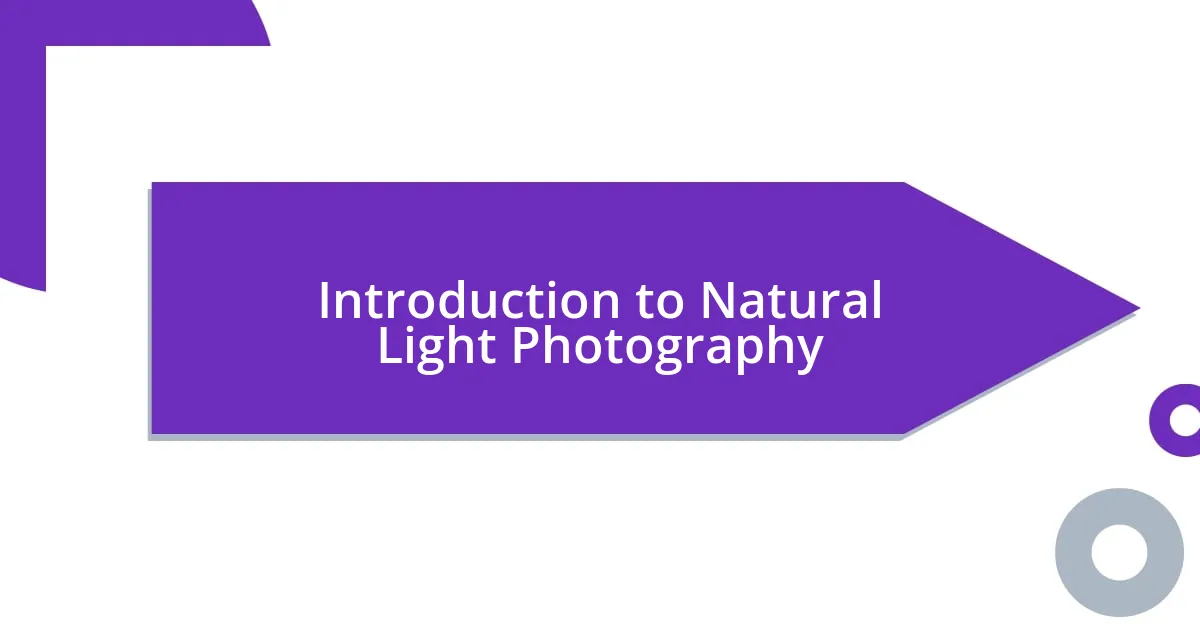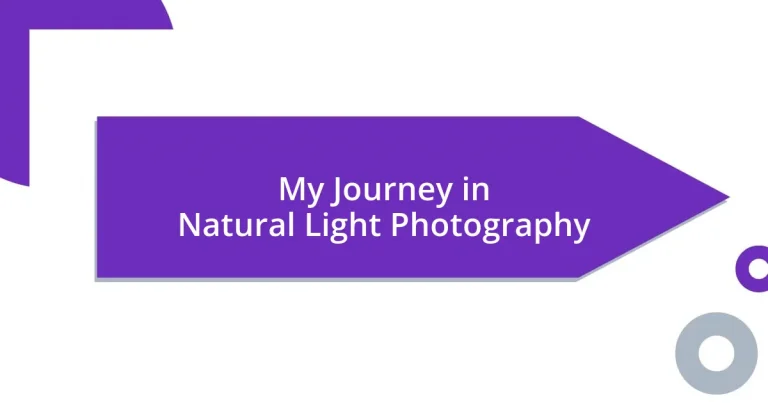Key takeaways:
- Natural light photography captures the essence of moments, evoking emotions through the artful embrace and adaptation to changing light conditions.
- Understanding light quality (soft vs. hard) and direction (front, side, backlighting) is crucial for enhancing texture, mood, and dimension in images.
- Common mistakes include relying solely on sunny weather, ignoring shadows, and neglecting camera settings, all of which can hinder the quality of photographs.
- Personal experiences in photography highlight the joy of unpredictability and the connection with surroundings, reinforcing that photography is as much about the process as the final image.

Introduction to Natural Light Photography
Natural light photography has a unique charm that often feels like it captures the very essence of a moment. I remember the thrill of my first outdoor shoot; it was early morning, and the golden hour bathed everything in a warm glow. That experience taught me how sunlight can evoke emotions just as powerfully as any composition or subject matter.
When I talk about working with natural light, the conversation naturally drifts to its unpredictability. How often have you stepped outside, only to find that the light shifts dramatically within minutes? Embracing that change is part of the adventure. Learning to read and adapt to the light can elevate your images to another level, making each photograph feel alive and spontaneous.
In my journey, I’ve discovered that natural light can be both a friend and a foe. I vividly recall a midday shoot where harsh shadows seemed like they were mocking my efforts. But instead of giving up, I adjusted my approach—finding shaded areas that transformed the scene completely. This experience reinforced my belief that understanding light can turn challenges into opportunities, ultimately enhancing our artistic expression.

Understanding Light Quality and Direction
When it comes to natural light photography, quality and direction are crucial elements that profoundly influence your images. I remember a particular sunset shoot at a beach, where the soft, golden light transformed the scene into a dreamy palette. The way light sprawls and wraps around subjects can create mood. As I learned, the direction of light can add depth and dimension, often enhancing texture and details that might otherwise be lost.
Here are some aspects to consider:
-
Quality of Light:
- Soft vs. Hard Light: Soft light, like on cloudy days, tends to wrap around subjects, reducing shadows. In contrast, hard light creates stark shadows and sharp contrasts, adding drama.
- Color Temperature: The warmth of light changes throughout the day. Early mornings and late afternoons often produce golden tones, while midday light can feel cooler and harsher.
-
Direction of Light:
- Front Lighting: This can brighten a scene but may flatten textures. It’s useful in enhancing colors.
- Side Lighting: It often introduces depth and adds textures to your images, creating striking contrasts.
- Back Lighting: Shooting against the light can produce stunning silhouettes and capture the glow around your subject, but requires more attention to exposure.
Understanding these elements turned my photography experience into a more intentional practice. The nature of light constantly shifts, and interpreting it isn’t just a technical skill—it’s about embracing its emotional language.

Techniques for Capturing Stunning Images
Understanding the different techniques for capturing stunning images in natural light can significantly enhance your photography skills. While experimenting with shadows, I recall a serene afternoon spent in a garden, where I discovered how dappled light filtered through leaves can create a magical pattern. This taught me that using shadows creatively can add depth and intrigue, providing a natural frame for your subjects.
One of the essential techniques is to use reflectors to bounce light onto your subject. I often carry a simple white board or even a piece of aluminum foil, which can make a world of difference. By reflecting light strategically, I’ve managed to highlight a subject’s features, bringing out details that otherwise would have been lost. This practical approach has transformed mundane shoots into vibrant visuals that capture the spirit of the moment.
Here’s a comparison of common techniques used in natural light photography that I’ve found helpful:
| Technique | Description |
|---|---|
| Backlighting | Creates silhouettes and enhances glow around subjects. |
| Reflectors | Bounces light onto subjects, reducing shadows and enhancing details. |
| Use of Shadows | Adds depth and interest, creating natural frames around subjects. |
| Golden Hour Shooting | Leverages soft, warm light during the early morning or late afternoon. |
| Diffused Light | Shooting on overcast days for softer shadows and reduced contrast. |
Utilizing these techniques allows you to embrace the natural world and create compelling images that draw viewers in. What has been your experience with these methods? I encourage you to experiment and find your unique style!

Common Mistakes to Avoid
Avoiding common mistakes in natural light photography can really elevate your images. One mistake I often see is relying solely on the sunny weather. I used to chase bright sunlight, believing it always yielded the best results, but I learned that overcast days can actually create incredibly soft, flattering light. Have you ever tried shooting during a cloudy afternoon? The depth and detail you can achieve in those conditions can be quite extraordinary.
Another pitfall is disregarding shadows entirely. Initially, I avoided shadows—thinking they would ruin my photos. But now, I embrace them; they add dimension and interest to my images. I remember snapping a photo of a flower surrounded by shadows, and the outcome was stunning! It transformed an ordinary shot into something captivating. So, don’t shy away from those dark areas; they can enhance your composition rather than detract from it.
Finally, one mistake I often made was neglecting to check my camera settings before shooting. When I was excited about capturing the perfect moment, I would forget to adjust my aperture or shutter speed, which often resulted in underexposed images. Now, I always take a moment to assess my settings. Do yourself a favor—take that extra minute to ensure you’re ready to capture the essence of the moment.

Personal Reflections and Learning Experiences
As I reflect on my journey in natural light photography, I can’t help but smile at the moments that felt like pure serendipity. I remember one late afternoon where I wandered into a field and stumbled upon a family of deer. The soft gold light wrapped around them, illuminating their graceful forms against the backdrop of tall grass. It was in that instant that I realized how beautiful unpredictability can be in nature; sometimes, the best subjects appear when you least expect it.
Learning to see light in its many forms has been an enlightening experience. I initially found myself overwhelmed, but with each click of the shutter, I began to develop a deeper connection with my surroundings. There was a day when the sun dipped below the horizon, casting a warm hue over everything. I felt compelled to capture that fleeting moment, and as the colors blended together, I experienced a sense of calmness. It taught me to appreciate the transient beauty in every setting; light changes, and so do we.
Have you ever felt that rush of creativity when capturing a stunning photograph? I vividly remember a time when I tried shooting my friend’s portrait during a golden hour. I was thrilled as I played with angles, chasing the light that danced on her hair. The laughter, the experimentation, and the sheer joy of creating something beautiful together revealed to me that photography is not just about the final image but the experience shared. It’s these moments that have shaped my love for natural light photography, reminding me to keep an open heart and mind.












